-
Why Machine Learning (ML) and Artificial Intelligence (AI) Are Key Technologies for SD-WAN
- What Is WAN Optimization (WAN Acceleration)?
- What Is Secure SD-WAN? | What It Is and How It Works
- What Is SD-WAN as a Service (SD-WANaaS)?
-
What Is SD-WAN Security? | SD-WAN Security Considerations
- What are the main security challenges of SD-WAN?
- What are the primary SD-WAN security features?
- What is AI’s role in improving SD-WAN security?
- What is the role of SASE in SD-WAN security?
- Do next-generation SD-WAN solutions provide better security?
- What is the difference between SD-WAN security and secure SD-WAN?
- SD-WAN security FAQs
- What Is Next-Generation SD-WAN?
-
What Is Managed SD-WAN?
- How does managed SD-WAN work?
- What are the differences between DIY and managed SD-WAN?
- Why do businesses need managed SD-WAN?
- Types of managed SD-WAN deployments
- What are the pros and cons of managed SD-WAN?
- What is the difference between managed SD-WAN and SD-WAN as a service?
- How to choose the right deployment model: managed SD-WAN, DIY, or a combination
- What Is Hybrid SD-WAN?
-
Branch Network Security | Securing Branch Networks with SD-WAN
-
What Is an SD-WAN Appliance? | SD-WAN Hardware & Equipment
- How do SD-WAN appliances work?
- What are the different types of SD-WAN appliances?
- What are the different SD-WAN appliance deployment models?
- What are the benefits of SD-WAN appliances?
- What are the common features of SD-WAN appliances?
- Security considerations for SD-WAN appliances
- How to choose the right SD-WAN appliance for your needs
- SD-WAN appliance FAQs
-
What Is an SD-WAN Gateway? | Definition, Explanation, Use Cases
- What are the limitations of hub-and-spoke architecture?
- What is the purpose of an SD-WAN gateway?
- What are the primary SD-WAN gateway use cases?
- What are the features of an SD-WAN gateway?
- What are the different types of SD-WAN gateway form factors?
- What are the disadvantages of an SD-WAN gateway?
- SD-WAN gateway FAQs
-
Traditional WAN vs. SD-WAN: What Are the Differences?
- How did traditional WAN evolve into SD-WAN?
- What is a WAN?
- What is SD-WAN?
- What are the differences between SD-WAN and WAN?
- What are the similarities between SD-WAN and WAN?
- What makes SD-WAN a better choice over WAN?
- When is traditional WAN the right choice?
- How to choose between WAN and SD-WAN
- Traditional WAN vs. SD-WAN FAQs
-
Top 5 Requirements for Securing Your Branch Offices
-
SD-WAN vs. NaaS: What Are the Differences?
- SD-WAN and NaaS in the current network services market
- What is SD-WAN?
- What is NaaS?
- What are the differences between SD-WAN and NaaS?
- What are the similarities between SD-WAN and NaaS?
- Will NaaS replace SD-WAN?
- How can SD-WAN and NaaS work together?
- What is the future of SD-WAN and NaaS?
- How to choose between SD-WAN and NaaS
- SD-WAN vs. NaaS FAQs
- How Do 5G and SD-WAN Work Together?
- SD-WAN vs MPLS vs Internet: What’s the Difference? Which is Right for Your Organization?
-
Types of SD-WAN Deployment Models: A Complete Guide
- Understanding modern SD-WAN capabilities and options
- What is SD-WAN?
- Types of SD-WAN management models
- DIY SD-WAN
- Fully managed SD-WAN
- Co-managed SD-WAN, aka Hybrid
- Managed CPE SD-WAN
- SD-WAN as a Service (SD-WANaaS)
- Types of SD-WAN deployment architectures
- Hub-and-spoke
- Mesh
- Hybrid mesh
- Types of SD-WAN deployment environments
- On-premises SD-WAN
- Cloud-based SD-WAN
- Hybrid SD-WAN
- How to choose the right SD-WAN deployment option for your business
- SD-WAN deployment models FAQs
- Top 7 SD-WAN Challenges: SD-WAN Risks, Issues, & Solutions
- MPLS | What Is Multiprotocol Label Switching
-
How to Execute an MPLS to SD-WAN Migration Step-by-Step
- Why do organizations switch from MPLS to SD-WAN?
- How is SD-WAN a better alternative to MPLS?
- What are the options for migration from MPLS to SD-WAN?
- Should you use an MSP for your MPLS to SD-WAN migration?
- What are the MPLS to SD-WAN migration challenges you can expect?
- Is there a middle ground between MPLS and SD-WAN?
- If your organization is planning an MPLS to SD-WAN migration, is SASE worth considering?
- How to create a successful MPLS to SD-WAN migration plan
- MPLS to SD-WAN migration FAQs
- How much does SD-WAN cost?
- How Does SD-WAN Automation Simplify Network Operations?
- How Are Firewalls and SD-WAN Related?
- How SD-WAN helps Today’s IoT
-
What Is SD-WAN Multicloud?
- What is the Difference Between SD-WAN and MPLS?
What are the differences between SD-WAN and SDN?
The difference between SD-WAN and SDN is that SD-WAN optimizes WAN connectivity for branch offices and remote sites, while SDN manages and controls network resources within data centers and local networks.
SD-WAN uses multiple internet connections to provide flexible, cost-effective WAN performance. SDN centralizes network management and control with software-based controllers, improving efficiency and scalability in complex network environments.
What is SD-WAN (software-defined wide area network)?
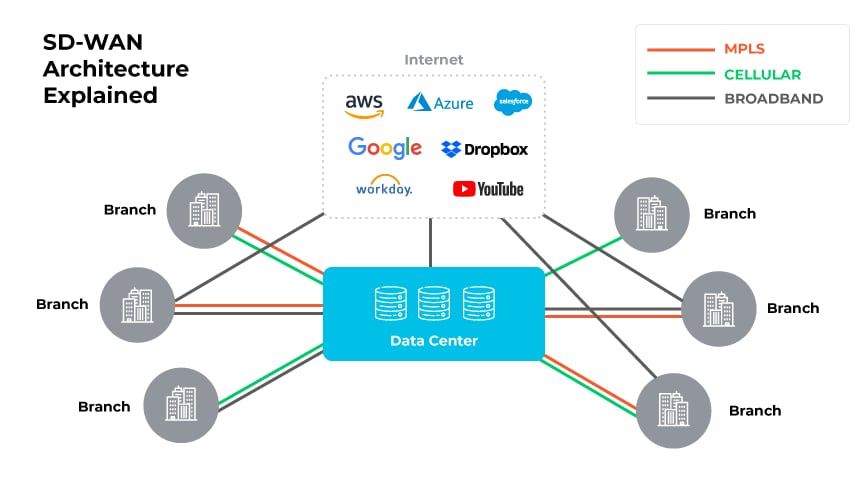
SD-WAN (software-defined wide area network) is a networking technology that applies software-defined networking (SDN) principles to manage and optimize wide area networks (WANs).
It gives organizations the ability to securely connect users, applications, and data across multiple locations. Which means better performance, reliability, and scalability.
How?
Essentially, SD-WAN simplifies WAN management by centralizing control and providing visibility across the full network.
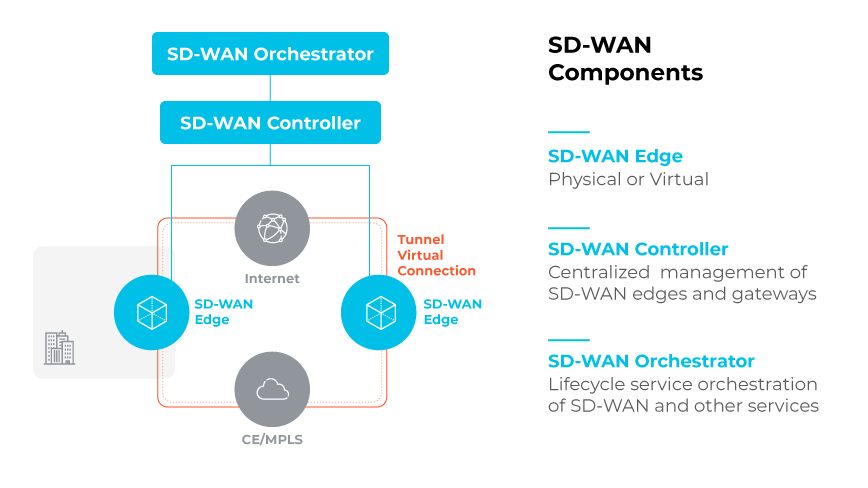
SD-WAN works as a virtualized service that spreads enterprise networks over large geographical areas. It uses various types of links, including multiprotocol label switching (MPLS), wireless, broadband, virtual private networks (VPNs), and the internet. These links connect users in branch and remote offices to corporate applications and resources.
Plus, by monitoring WAN performance and managing traffic, SD-WAN maintains high speeds and optimizes connectivity.
SD-WAN originally came into being because businesses needed a more efficient, flexible approach to network management. And its centralized control plane does just that: simplifies network management and enhances service delivery.
Today, SD-WAN supports the dynamic, programmable nature of modern networks. So organizations can adapt quickly to changing needs and improve network performance at the same time.
What is SDN (software-defined networking)?
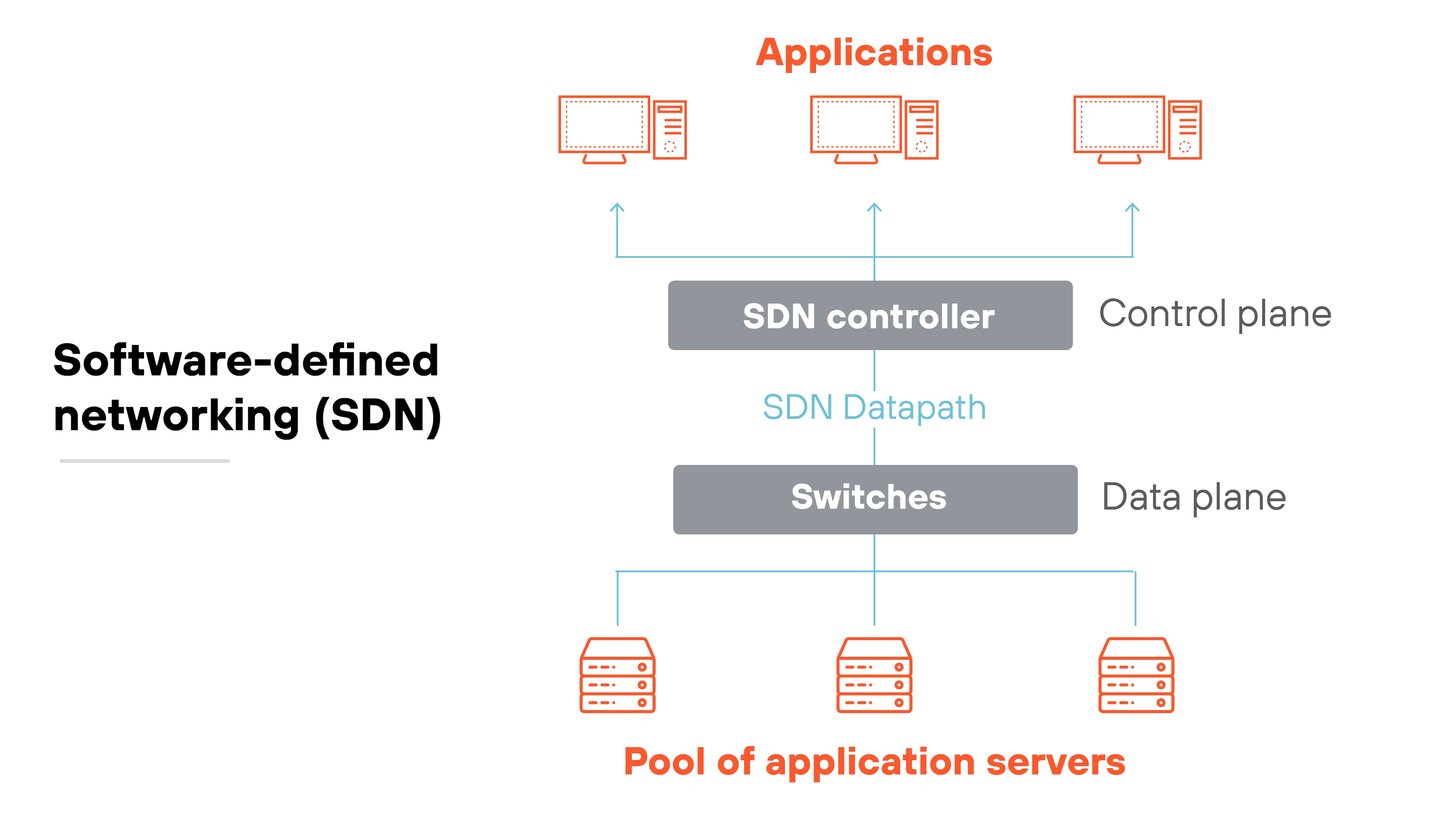
Software-defined networking (SDN) is a network architecture approach that decouples the network control plane from the forwarding plane. That makes it possible to centralize network management and control.
In a traditional network, each device handles both forwarding and controlling network traffic. This can be a big contributor to inefficiencies.
Why?
Because it increases complexity and can cause bottlenecks. Basically, since each device must maintain its own control logic, inconsistent policies and configurations tend to get out of hand across the network.
Bottlenecks crop up because devices have to process data packets and control commands, slowing down overall performance. So when network changes are needed, updating each device individually can be very time-consuming—and error-prone. And that means potential delays and misconfigurations.
By separating the network control plane from the forwarding plane, SDN allows for more flexible, efficient network management.
SDN uses software-based controllers or application programming interfaces (APIs) to communicate with underlying hardware infrastructure and manage network traffic.
The SDN controller makes decisions about network traffic routing. Which leads to better network performance and less complexity.
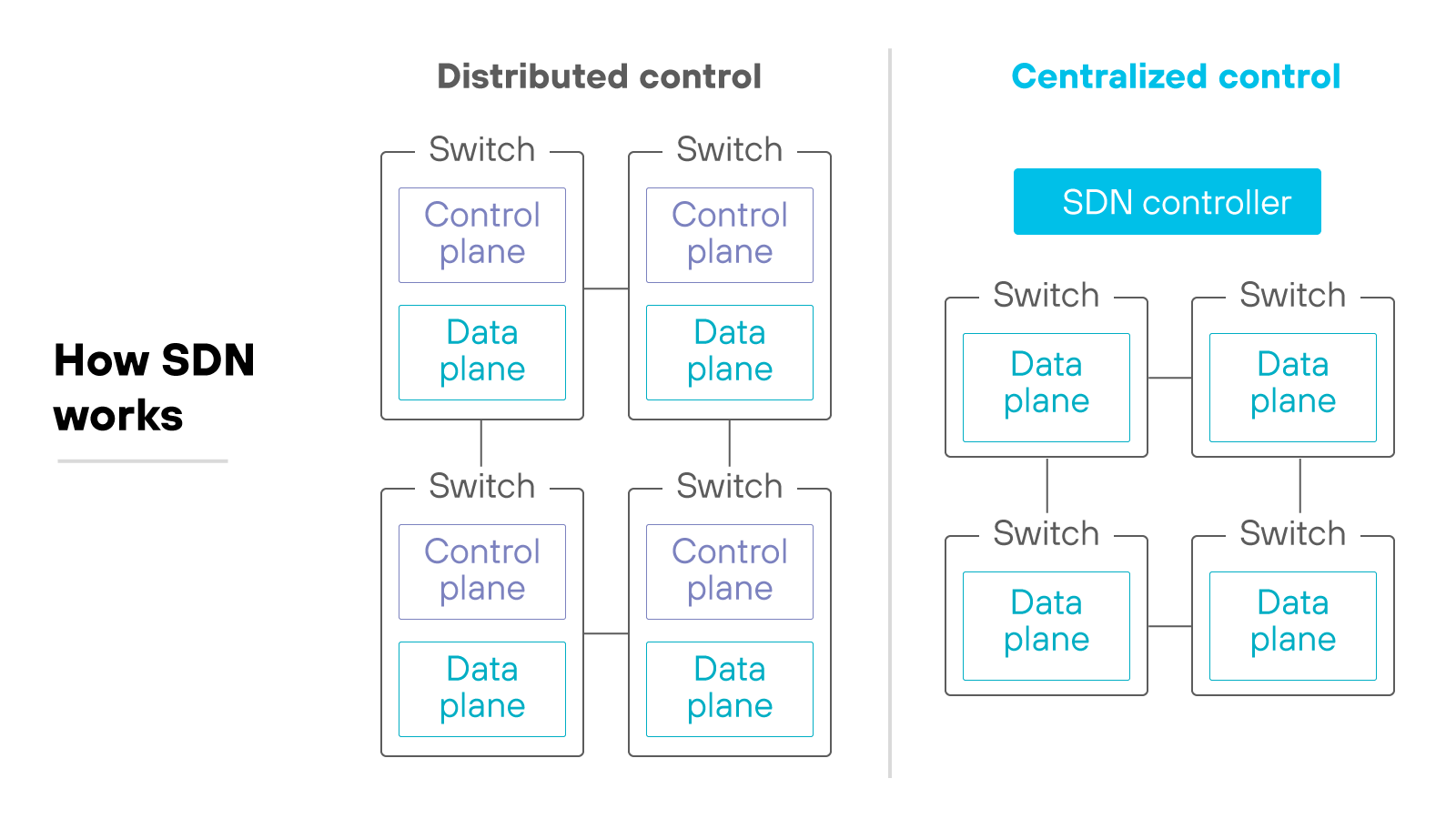
Centralized control means that network admins can configure and manage the network from one location. And that makes network operations simpler.
The concept of SDN emerged because businesses needed a way to support dynamic, scalable, and flexible network connectivity. The development was also driven by the fact that data center and core network requirements were evolving fast–thanks to cloud computing, virtualization, big data analytics, connected devices, etc.
In fact, SDN’s origins can be traced back to Stanford University's Ethane project. The project led to the development of OpenFlow, an early SDN protocol. OpenFlow separated network control from data forwarding by using a central controller to manage switch flow tables.
Ultimately, this paved the way for modern SDN implementations.
Primary SD-WAN use cases
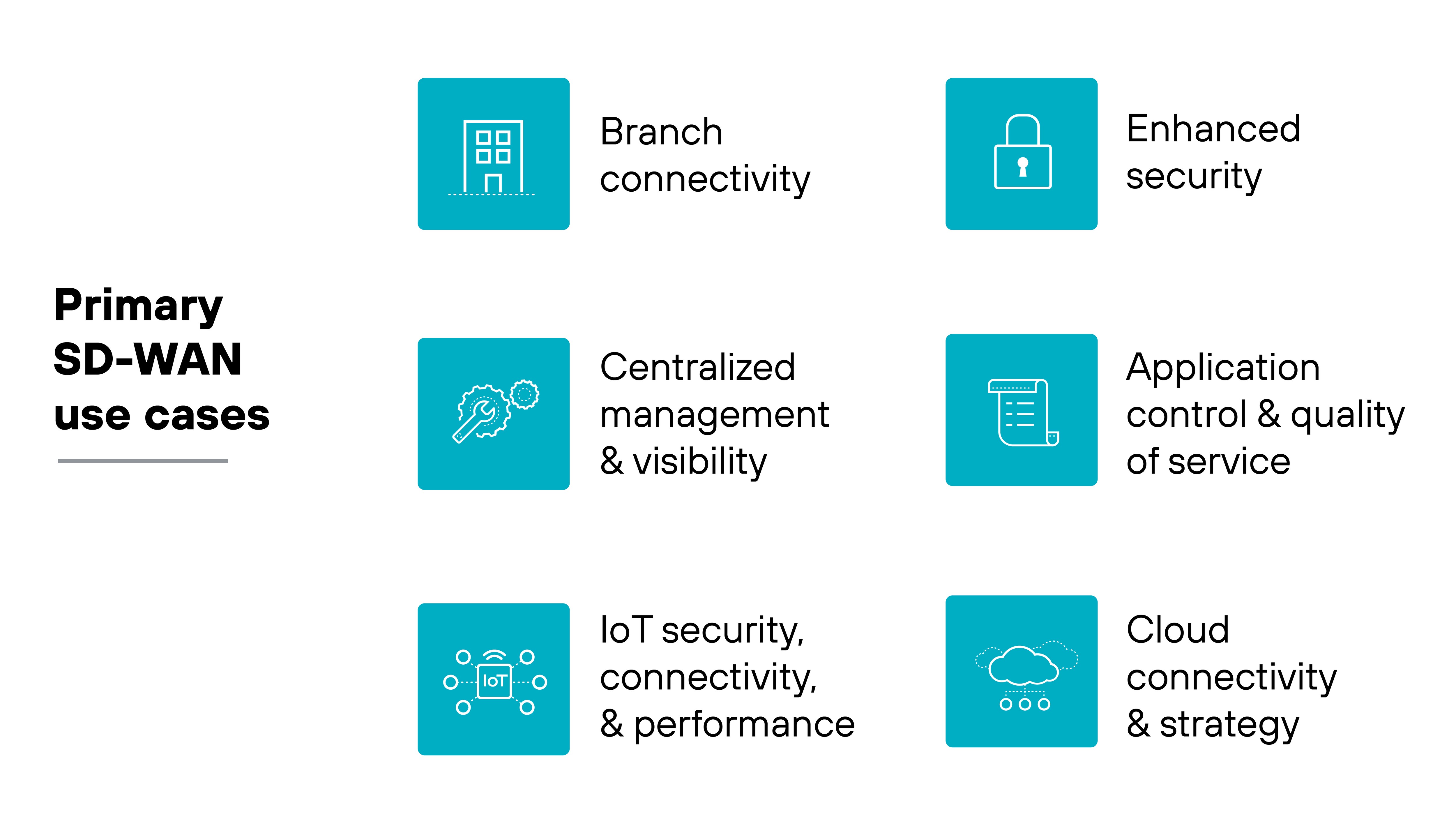
SD-WAN is a transformative technology because it solves multiple modern network infrastructure problems. Such as network complexity, inefficient bandwidth usage, and security challenges. Its primary use cases demonstrate how SD-WAN can majorly improve network performance, security, and management.
Branch connectivity
One of the primary use cases for SD-WAN is connecting branch offices to the main corporate network.
Unlike traditional networks that rely on a hub-and-spoke model, SD-WAN actually allows branches to connect directly to data centers or the cloud. Direct connectivity reduces transit time and eliminates bottlenecks.
Also, SD-WAN chooses the best network path depending on the traffic type. And this improves application performance.
Cloud connectivity and strategy
SD-WAN is very effective at improving cloud connectivity. Plus, it supports cloud-first strategies, which are becoming the norm.
Traditional WAN architectures usually route traffic through a centralized data center…so they’re not efficient for cloud applications. But SD-WAN provides a direct path from branch offices to cloud services.
In other words, SD-WAN makes sure cloud-based apps can take the most efficient route. Consequently, performance is better, and there’s far less latency.
Enhanced security
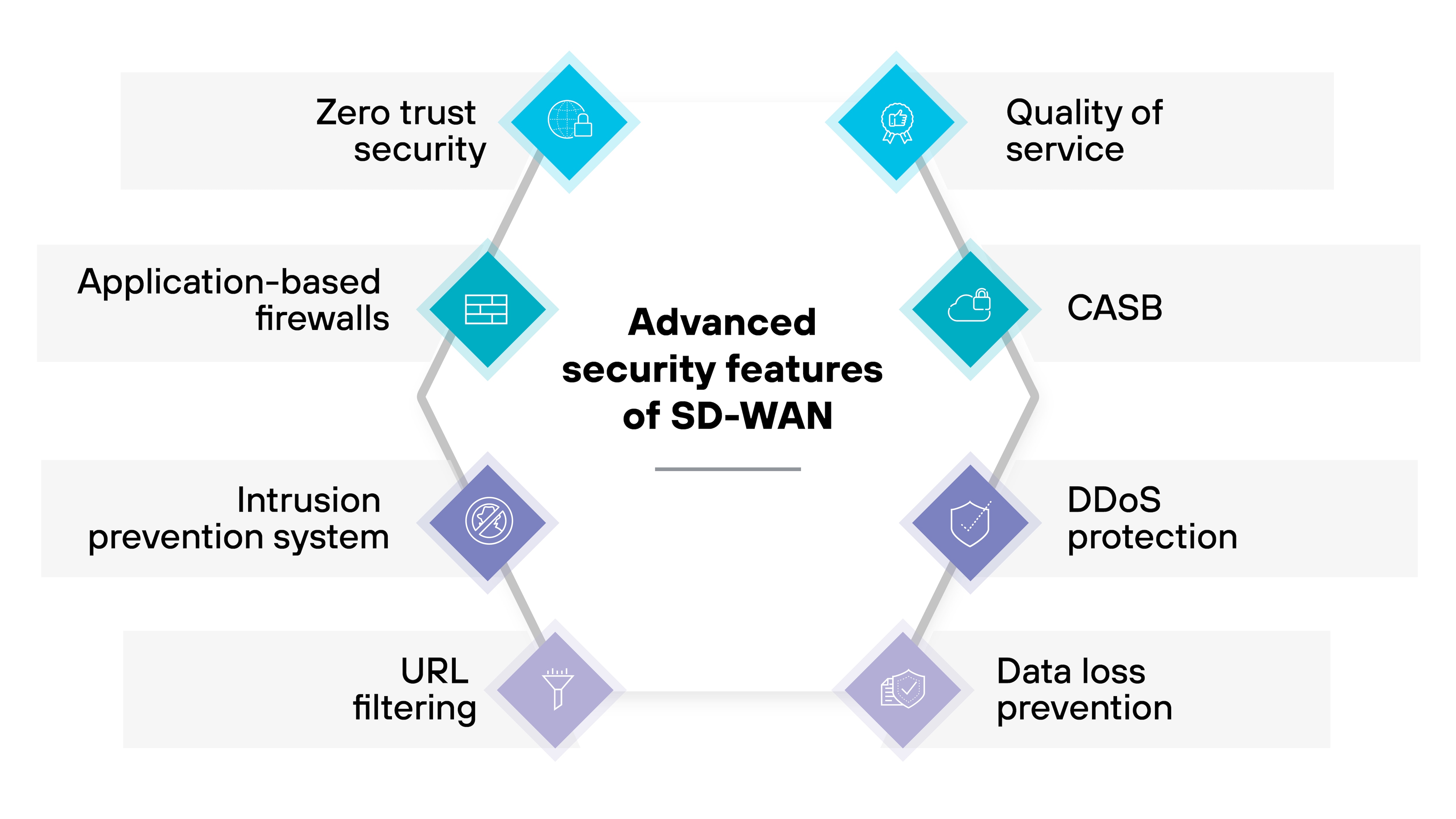
Security is a major driver for SD-WAN adoption.
First, because high end SD-WAN solutions typically offer advanced security features like application-based firewalls, intrusion prevention, and URL filtering.
SD-WAN solutions also provide secure, direct internet access for branches. On top of that, they eliminate the need to backhaul traffic to a central data center for inspection.
These features and functionalities combined significantly enhance security.
Centralized management and visibility
SD-WAN gives admins total visibility into network operations and traffic. As a result, it’s far easier for them to pinpoint network issues and resolve them immediately.
Then there’s the fact that centralized management shifts the network's control plane from individual branch routers to a central tool. Making it easy to deploy new branches fast and simplifying network management.
Application control and quality of service
SD-WAN allows admins to define service-level agreements (SLAs) for apps to be sure that critical ones take the best path across the network.
It also provides application-aware quality of service (QoS) capabilities. This makes it possible to prioritize mission-critical applications over less important ones.
The end result is that essential applications perform at high levels, and the network is more efficient overall.
IoT security, connectivity, and performance
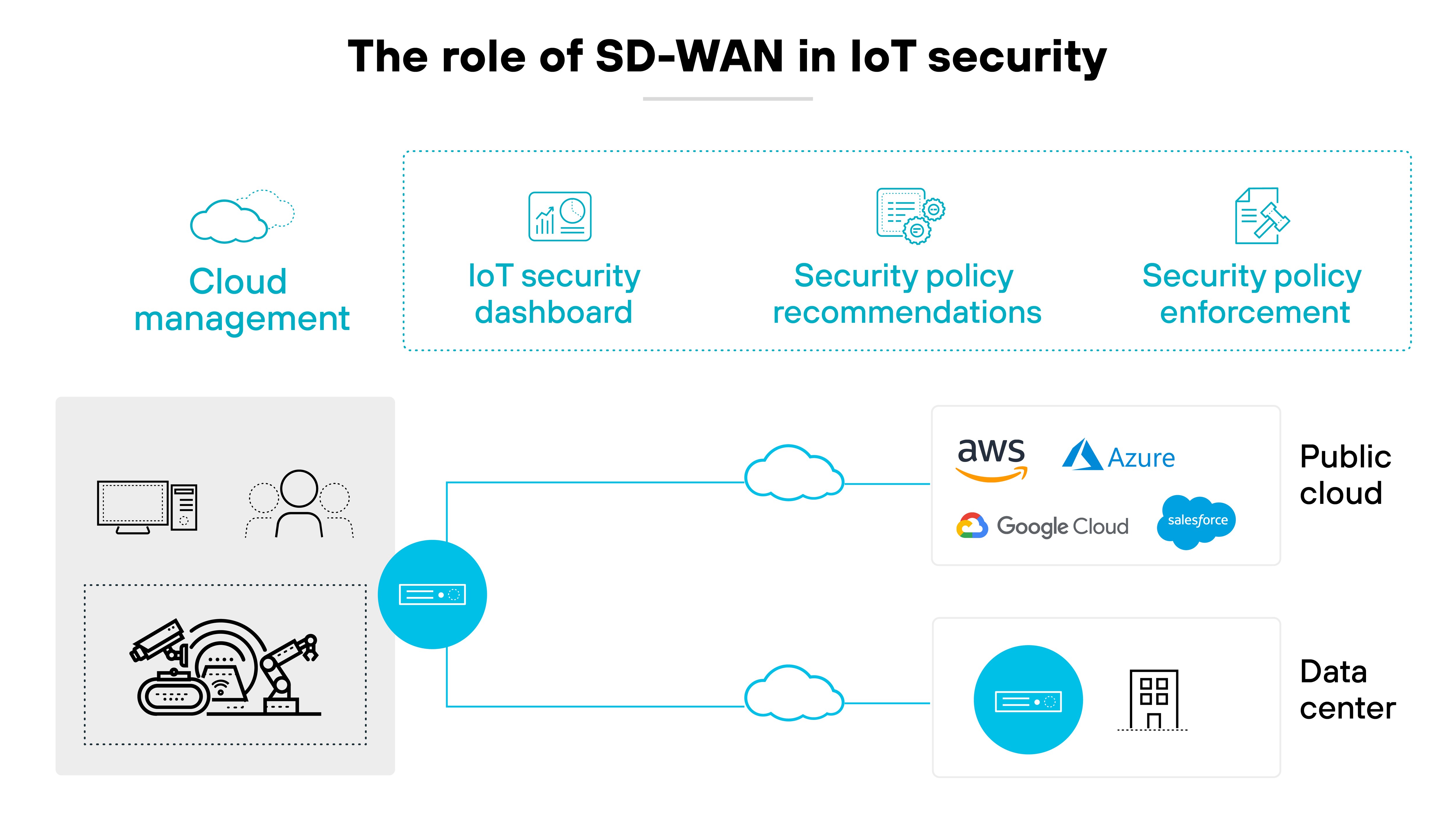
SD-WAN solutions are well suited for meeting the connectivity needs of a rapidly growing population of IoT devices.
In the same way that standard networks benefit from software-defined operation, IoT networks benefit from the performance monitoring, aggregation, real-time routing and path selection of SD-WAN technologies.
SD-WAN helps IoT security by providing protection against external threats like DDoS attacks and malware. It ensures only authorized IoT devices can access the network and blocks unapproved devices, data, and locations automatically.
And SD-WAN applies security policies from centralized cloud or on-premises sources. That gives organizations comprehensive protection with anti-spyware, web filtering, anti-malware, and antivirus measures.
Further reading:
- Branch Network Security: Securing Branch Networks with SD-WAN
- What Is SD-Branch? Centralized Security for Branch Networks
- What Is the Cloud-delivered Branch?
- How SD-WAN Helps Today’s IoT
Primary SDN use cases
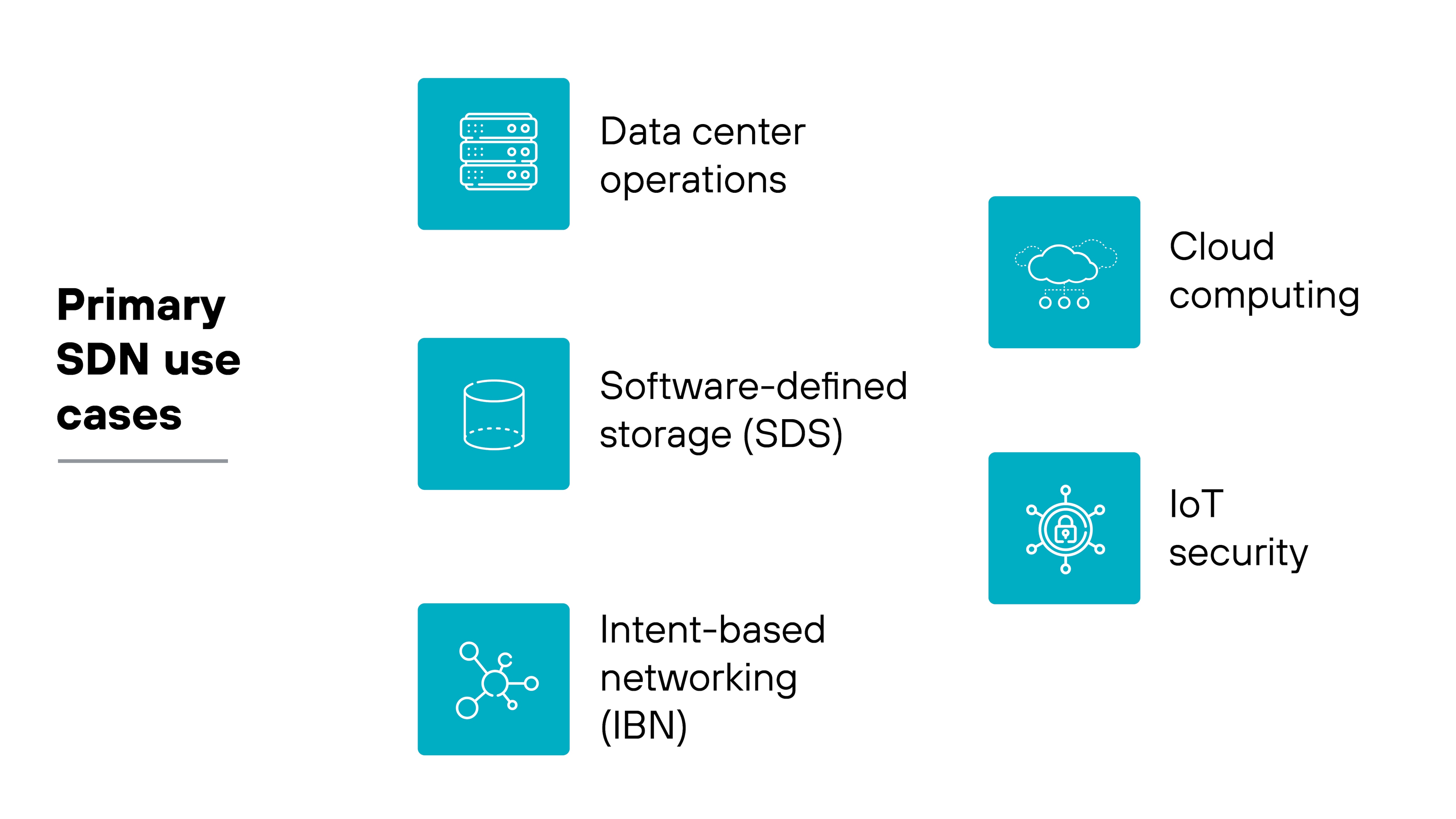
Organizations use SDN in various scenarios: data center operations, cloud computing, software-defined storage, IoT security, and intent-based networking. It’s relatively flexible, which is why it can address diverse needs, optimize network resources, and improve performance.
Data center operations
Organizations often rely on SDN in data centers to enhance security, optimize network performance, and automate provisioning.
Cloud computing
In cloud environments, SDN facilitates on-demand network services that scale easily. The flexibility allows for efficient, responsive network performance.
It also helps simplify the deployment and management of cloud-based apps.
Software-defined storage (SDS)
SDN supports SDS by automating network tasks and ensuring connectivity. The integration optimizes storage resource use and makes provisioning, allocation, and management simpler.
The outcome is better storage performance.
IoT security
IoT environments often have multiple vulnerable access points. SDN provides centralized, customizable protection for IoT environments.
And it enforces comprehensive security policies to prevent unauthorized access and reduce possible risks.
Intent-based networking (IBN)
SDN enables intent-based networking (IBN) by allowing admins to define their desired outcomes and policies—which the system then implements.
This approach aligns network operations with organizational objectives. So business goals are supported.
What are the benefits of SD-WAN?
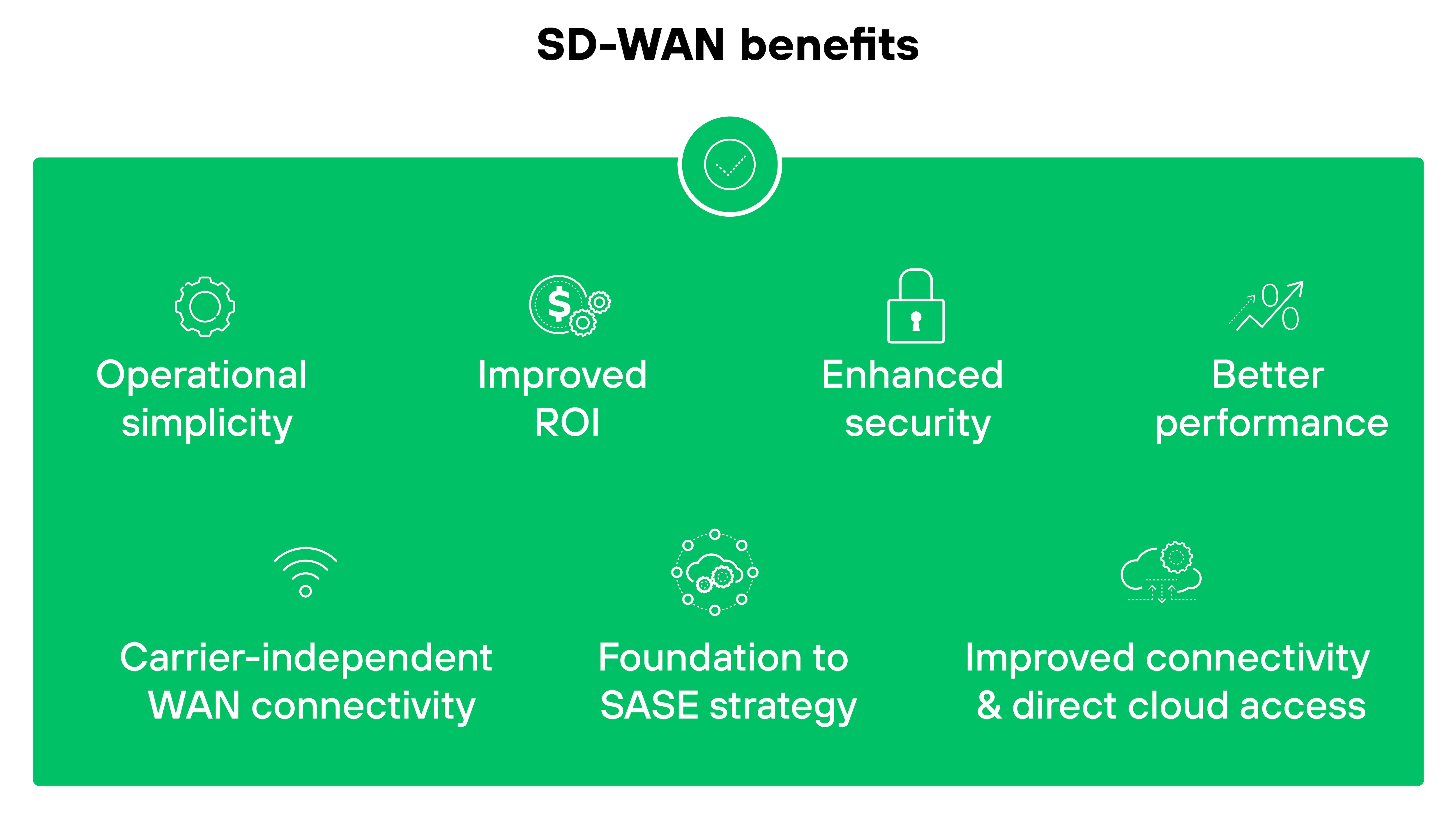
SD-WAN architecture combines multiple functionalities into one centrally managed platform. For many organizations, this transforms the network into a substantially more adaptable, secure, and manageable utility.
Operational simplicity
SD-WAN simplifies network management using a centralized controller. The centralized controller facilitates zero-touch provisioning for branch networks. Meaning that organizations can set up new branches without having to be on-site to conduct manual configuration.
This amounts to less manual operations, resource needs, and planned downtime when setting up new locations.
Carrier-independent WAN connectivity and improved ROI
SD-WAN makes it possible to use various internet service providers (ISPs) based on location or current pricing. If an ISP encounters connectivity issues, network stability remains uncompromised.
SD-WAN reduces CAPEX, too. It replaces expensive MPLS circuits with affordable broadband or internet connections. Which equals less capital expenses and better network performance.
Additionally, SD-WAN offers much simpler management and deployment. That lowers maintenance and support costs. The investment in SD-WAN recoups relatively quickly, and then generates further savings—so ROI is improved overall.
Improved security
SD-WAN enhances network security because it prioritizes traffic and optimizes connectivity. Prioritized traffic leads to faster detection and response to threats. And when traffic takes the most efficient, secure route, there’s less exposure to threats to begin with because there aren’t any unnecessary hops.
Also, SD-WAN can be seamlessly integrated with various security functions. SD-WAN is a component of the SASE framework. Adopting SASE brings features like secure web gateways and cloud access security brokers to the table, leading to comprehensive protection and a robust security posture.
Enhanced performance
SD-WAN smartly directs network traffic using SLAs for consistent application performance. It can also switch to better-performing WAN connections if needed.
Additionally, open APIs make it fairly easy to customize services and integrate with external applications. Like security and performance monitoring tools.
Improved connectivity and direct cloud access
SD-WAN offers direct and optimized access to cloud services. This eliminates the need for traffic backhauling through central hubs. Dynamic pathway adaptation ensures smooth data flow, reducing lags and enhancing the overall user experience.
Foundation to SASE strategy
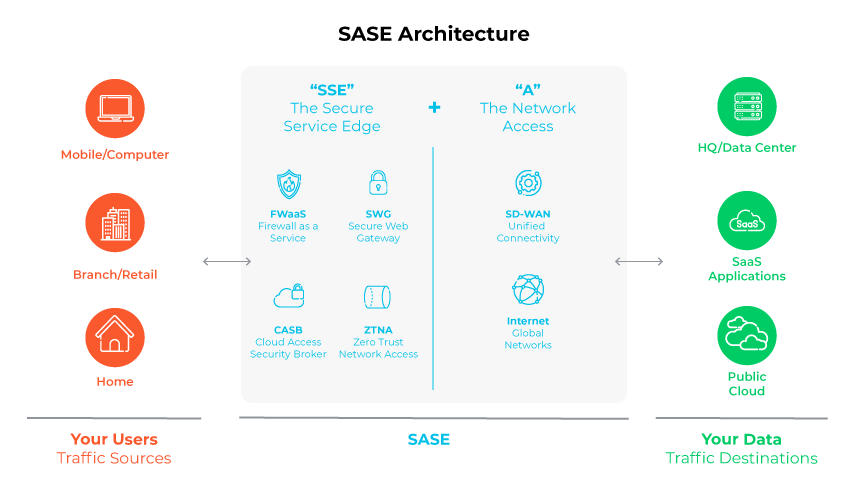
Given that SD-WAN is a foundational component of SASE, it’s not surprising that its adaptability and cost-efficiency are vital for developing a SASE strategy.
In the SASE model, network security shifts to the cloud. SD-WAN ensures optimal performance and resilient connectivity. Setting the stage for advanced cloud-based security measures. This makes deploying SASE much easier and more effective.
Further reading:
- What Are the Benefits of SD-WAN?
- How Does SD-WAN Automation Simplify Network Operations?
- What Is SD-WAN Multicloud?
What are the benefits of SDN?
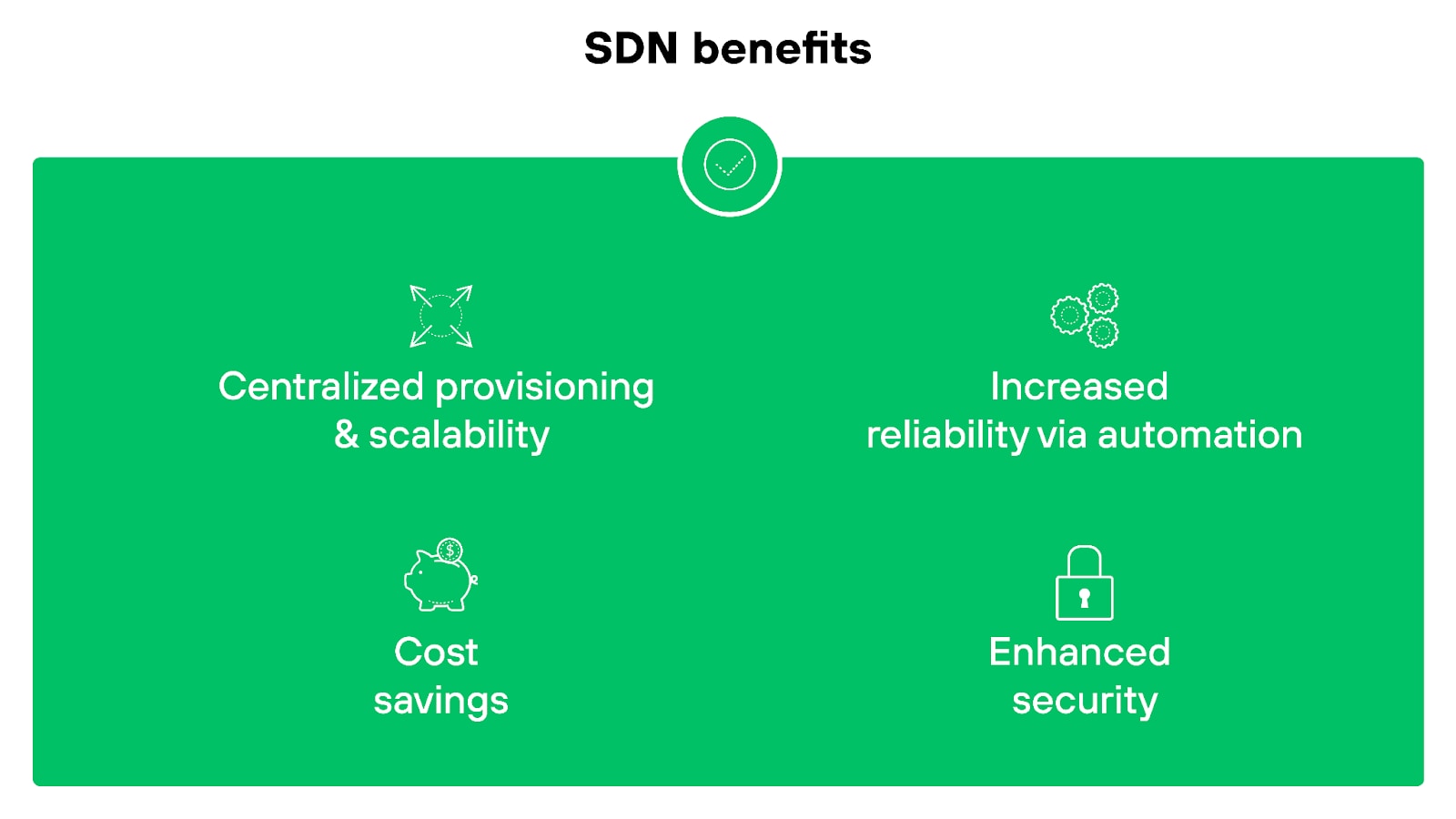
Centralized provisioning and scalability
One of the primary benefits of SDN is centralized provisioning, which virtualizes both the data and network control planes.
Centralization allows network admins to manage physical and virtual elements from one place. That enhances network scalability and makes it easier to make adjustments to network infrastructure, quickly and efficiently.
Enhanced security
SDN offers security benefits because it establishes a central control point for network security policies. Since admins can manage the entire network's security from one place, implementing and enforcing security measures is easier.
Increased reliability via automation
SDN enhances network reliability because it applies automation. Automated processes can reroute traffic in real time to avoid outages and keep connectivity consistent.
Cost savings
Implementing SDN can lead to significant cost savings.
It reduces the need for redundant equipment because it provides real-time rerouting and dynamic resource allocation. Thus lowering overall expenditure on hardware and maintenance.
What are the potential implementation challenges of SD-WAN?
As with all technologies, implementing SD-WAN can present several challenges. Particularly in vendor selection and network integration.
The market is saturated with vendors offering various features, which can make it tough for IT teams to choose the best fit for their specific needs.
Additionally, integrating SD-WAN with existing network infrastructure can be complex. But thorough research and understanding user workflows can help in making informed decisions.
Another common challenge is ensuring robust security and optimizing cloud connectivity. SD-WAN requires careful configuration to maintain security. Especially with direct internet access at branch locations.
However, SD-WAN implementation is approachable and well established, especially with the right strategies and vendor support. With a well-considered plan, organizations can successfully implement SD-WAN and reap its benefits.
What are the potential implementation challenges of SDN?
Implementing SDN can present several challenges, particularly in terms of integration and security.
Integrating SDN with existing legacy systems can be complex due to differences in protocols and architectures, and that can definitely lead to compatibility issues.
Also, the centralized control plane, a core element of SDN, can become a single point of failure— making it a prime target for cybersecurity threats.
Moreover, the initial cost of deploying SDN infrastructure can be high. These usually include expenses for new hardware, software, and training.
What are the differences between SD-WAN and SDN?
| Parameters | SD-WAN | SDN |
|---|---|---|
| Network architecture | Designed for WANs, uses multiple internet connections, optimizes performance with dynamic routing. | Focuses on LANs or service provider core networks, decouples control and forwarding planes for centralized management. |
| Deployment scenarios | Suitable for all sizes with multisite needs, flexible and cost-effective, deployable on various hardware and software platforms. | Deployed in data centers and large enterprise networks with high traffic levels, requires specialized hardware and software. |
| Management and control | Centralized management with decentralized control options, allowing some control to individual routers for flexibility. | Centralized management, all operations controlled through a central panel. |
| Security features | Built-in security measures like firewalls and VPN tunnels integrated into the architecture. | Requires additional security measures like external firewalls and intrusion detection systems. |
While both SDN and SD-WAN are software-defined networking technologies, they differ in network architecture, deployment scenarios, management and control, security features, and programmability.
The differences between SDN and SD-WAN make each technology suitable for specific use cases and organizational needs.
Network architecture
The primary difference between SDN and SD-WAN is network architecture.
Here’s how:
SDN focuses on the local-area network (LAN) or service provider's core network. Since it decouples the control and forwarding planes, network management centralization simplifies the monitoring and management of network resources.
But SD-WAN is designed for wide-area network (WAN) infrastructures. It uses multiple internet connections to provide WAN connectivity. SD-WAN optimizes network performance by dynamically routing traffic based on real-time conditions. And that adds up to flexibility in network design.
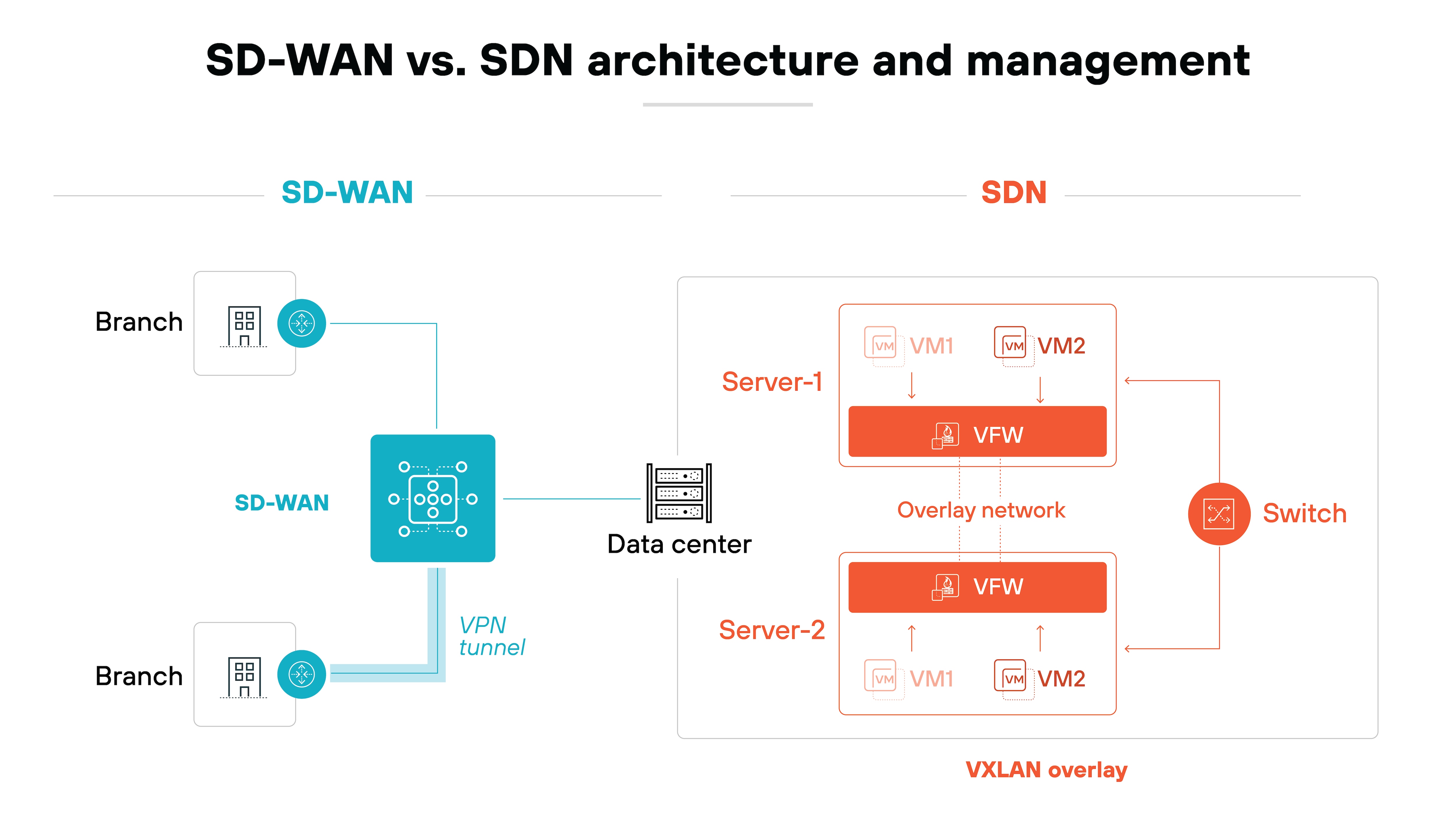
Management and control
As mentioned, SDN offers centralized network management, so all network operations are controlled through a central panel.
SD-WAN also offers centralized network management. And it does offer centralized control—but with decentralization options. It allows individual routers some management capabilities. This makes network operations more flexible and adaptable. Which works well for organizations with diverse, dynamic networking needs.
Deployment scenarios
SDN and SD-WAN also differ significantly in deployment scenarios.
SDN is typically deployed in data centers and large enterprise networks where high traffic levels and complex network architectures prevail. And it requires specialized hardware and software for optimal functioning.
SD-WAN is well suited for organizations of all sizes who have multi-site connectivity needs. It’s flexible by design and can be deployed on various hardware and software platforms. So it tends to be easier and more cost-effective to implement.
Security features
Both SDN and SD-WAN incorporate security features, but their approaches differ.
SDN typically requires additional security measures such as external firewalls, intrusion detection systems, and access control lists. It was primarily designed for network management rather than security. So supplementary security protocols are usually needed.
In contrast, SD-WAN includes built-in security measures like firewalls and VPN tunnels, which provide robust protection against cyber threats. These features are integrated into the SD-WAN architecture, enhancing overall security.
What are the similarities between SD-WAN and SDN?
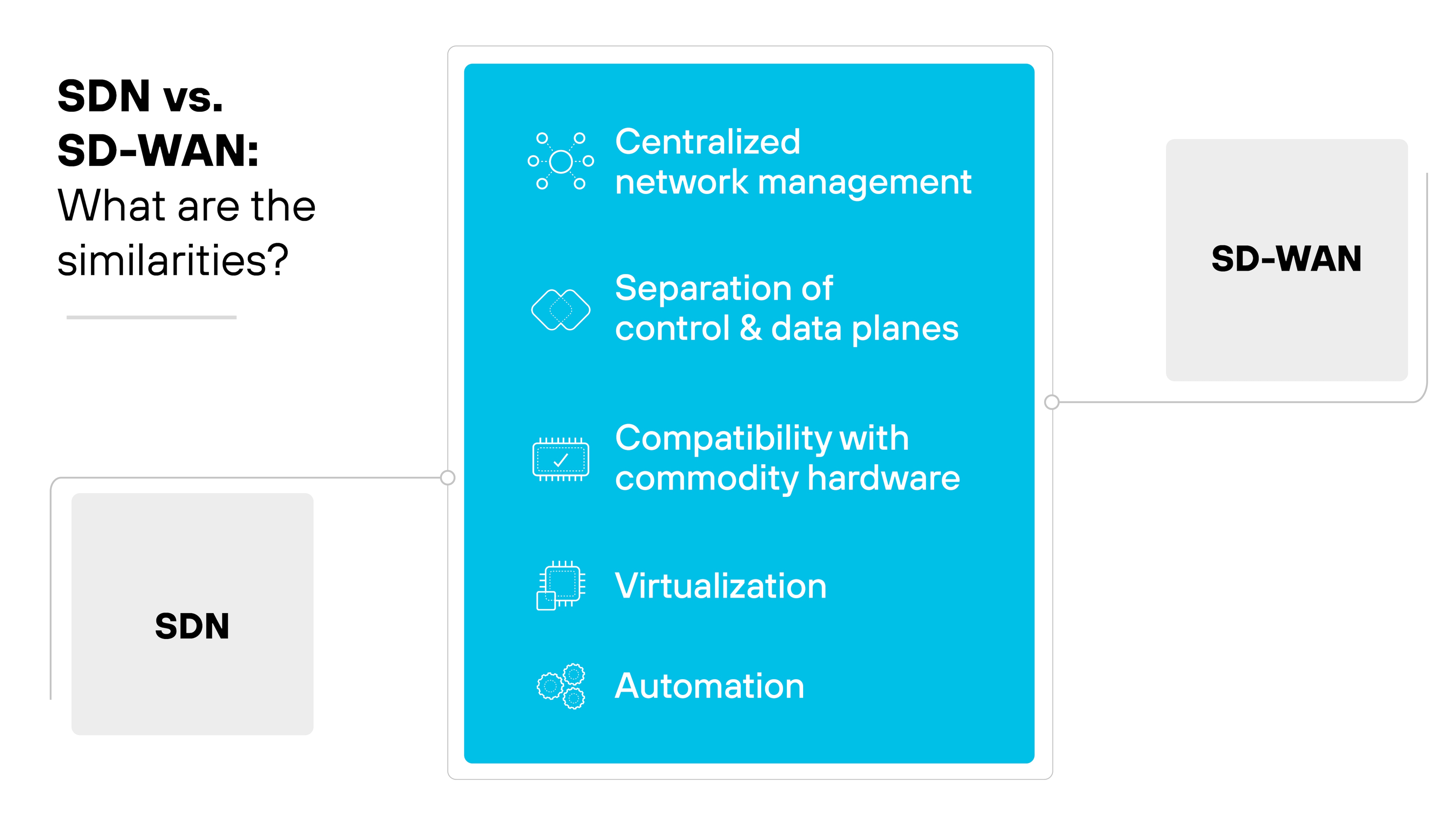
Software wide area network (SD-WAN) and software-defined networking (SDN) share several key similarities, including centralized network management, separation of control and data planes, compatibility with commodity hardware, virtualization, and automation.
These commonalities make both technologies efficient, flexible, and scalable network solutions.
Centralized network management
Both SD-WAN and SDN use centralized network management to control and orchestrate network resources. The approach improves visibility, simplifies operations, and reduces network administration.
Separation of control and data planes
A fundamental similarity between SD-WAN and SDN is the separation of the control plane from the data plane. The separation allows for dynamic and flexible traffic management, which is what enhances network performance.
Compatibility with commodity hardware
Both technologies are designed to run on commodity x86 hardware. There’s way less of a need for specialized equipment, and organizations can typically use existing infrastructure. The compatibility supports scalability and flexibility in network deployments.
Virtualization
Virtualization is a core component of both SD-WAN and SDN. It creates an abstraction layer that separates the physical network infrastructure from the software-defined control layer. Again simplifying network management, plus enabling the deployment of virtual network functions (VNFs).
Automation
SD-WAN and SDN apply automation to streamline network operations and reduce manual configurations. Automation minimizes human error and ensures consistent network performance. As well as greater flexibility in managing network resources dynamically based on real-time conditions.
How to choose between SD-WAN and SDN
Choosing between SD-WAN and SDN depends on the specific needs and network requirements of an organization.
SD-WAN is generally better suited for organizations that need to connect multiple geographically dispersed locations and require a flexible, cost-effective WAN solution. Since it optimizes traffic between remote sites to improve performance and reduce latency, SD-WAN is great for businesses with branch offices or remote workers.
On the other hand, SDN may be more appropriate for environments that require centralized network management within a single network or data center.
It’s not especially common for companies to be choosing strictly between SD-WAN and SDN. But some organizations may indeed find themselves evaluating both technologies based on their specific needs.
TIP
Many vendors offer free trials, so test your options before making a decision. Trials can help determine which solution best fits your needs by providing hands-on experience with the technology.
Organizations should evaluate network architecture, scalability needs, and management preferences to determine whether SD-WAN or SDN is the best fit for their operational goals.



